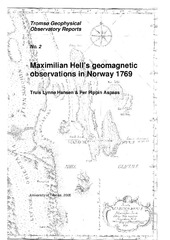Blar i tittel Artikler, rapporter og annet (TGO)
Viser treff 16-35 av 42
-
How Often Do Thermally Excited 630.0 nm Emissions Occur in the Polar Ionosphere?
(Journal article; Tidsskriftartikkel; Peer reviewed, 2017-12-17)This paper studies thermally excited emissions in the polar ionosphere derived from European Incoherent Scatter Svalbard radar measurements from the years 2000–2015. The peak occurrence is found around magnetic noon, where the radar observations show cusp-like characteristics. The ionospheric, interplanetary magnetic field and solar wind conditions favor dayside magnetic reconnection as the dominant ... -
Internasjonale forpliktelser
(Journal article; Tidsskriftartikkel, 1980)I forbindelse med at Nordlysobservatoriet har eksistert i 50 år kan det være på sin plass å spørre om det fortsatt er behov for virksomheten. Svaret er at observatoriet fyller en viktig oppgave i internasjonal forskning. -
Isolated lower mesospheric echoes seen by medium frequency radar at 70º N, 19º E
(Journal article; Peer reviewed; Tidsskriftartikkel, 2006-11-23)We have noted sporadic instances of strong isolated reflections of medium frequency (MF) radar waves from the mesosphere from as low as 50 km altitude and have devised a set of criteria for isolating these apparently anomalous echoes from those normally occurring from progressive partial reflections in the D-region. The object of this study is to map the occurrences of such echoes facilitating ... -
Maximilian Hell's geomagnetic observations in Norway 1769
(Research report; Forskningsrapport, 2005)In the years 1768-1770 an expedition lead by the Austrian/Hungarian astronomer and Jesuit Father Maximilian Hell travelled to Vardø in the northernmost part of Norway. The main objective of the expedition was to observe the transit of Venus in June 1769. However, scientific investigations in several other fields were also performed, among them observations of the magnetic declination. From the ... -
Mesospheric turbulence during PMWE-conducive conditions
(Journal article; Tidsskriftartikkel; Peer reviewed, 2007) -
Neutral atmosphere temperature trends and variability at 90 km, 70°N, 19°E, 2003-2014
(Journal article; Tidsskriftartikkel; Peer reviewed, 2016-06-27)Neutral temperatures at 90 km height above Tromsø, Norway, have been determined using ambipolar diffusion coefficients calculated from meteor echo fading times using the Nippon/Norway Tromsø Meteor Radar (NTMR). Daily temperature averages have been calculated from November 2003 to October 2014 and calibrated against temperature measurements from the Microwave Limb Sounder (MLS) on board Aura. ... -
A new five-wavelength photometer operated in Tromsø (69.6°N, 19.2°E)
(Journal article; Tidsskriftartikkel; Peer reviewed, 2018-12-11)A new fve-wavelength photometer was developed and installed at the EISCAT Tromsø site (69.6°N, 19.2°E) in January 2017. The photometer consists of two units: an optical unit and a control unit together with a PC. The photometer is capable of simultaneously observing auroral emissions with fve wavelengths. A uniqueness of the present system is its capability of precise pointing, which enables ... -
Nordlys i atmosfæren
(Journal article; Tidsskriftartikkel, 1980)Nordlyset er lys i atmosfæren som skyldes nedbør av energirike partikler - særlig elektroner, og de former og bevegelser vi ser i nordlyset skyldes variasjoner i denne atmosfæren. Når energirike elektroner nærmer seg jorden ovenfra, trenger de gjennom atmosfæren som stadig øker i tetthet. i 150-100 km's høyde blir atmosfærens tetthet så stor at elektronene begynner å kollidere med atmosfærenes atomer ... -
Nordlysets årsak
(Journal article; Tidsskriftartikkel, 1980)Nordlys dannes av gass og strømmer ut fra sola. Denne solvinden stoppes av jordas magnetfelt, og energien i vinden fra sola overføres til negative og positive ladede partikler (elektroner og protoner) som skytes ned fra jordatmosfæren og gir nordlys. Vi skal i det følgende fortelle litt om sola, og hvorfor det er en gasstrøm fra sola. Vi skal også diskutere hva som skjer når solvinden treffer sola -
Nordlysobservatoriet : historie og erindringer
(Book; Bok, 2000-03)Reidulv Larsen og Steinar Berger tilbragte begge det meste av sitt yrkesaktive liv på Nordlysobservatoriet, fra 1940-tallet og fram mot 1990. Gjennom et så langt tidsrom oppsamles et betydelig forråd av kunnskap om institusjonens liv og historie og minner fra arbeidet der. Dette heftet har form av en historisk oversikt, men gjør ikke krav på å være en komplett eller objektiv sådann. -
Nordlysobservatoriet gjennom 50 år
(Journal article; Tidsskriftartikkel, 1980)De mange forsøk på å beskrive og forklare nordlyset som en finner i eldre litteratur vitner om lange tradisjoner for denne forskningen i vårt land. Norge ble av mange oppfattet som "Nordlysets Fædreneland" som biskop Spidberg fra Kristiansand uttrykte det allere i 1750. -
On the contribution of thermal excitation to the total 630.0 nm emissions in the northern cusp ionosphere
(Journal article; Tidsskriftartikkel; Peer reviewed, 2017-01-25)Direct impact excitation by precipitating electrons is believed to be the main source of 630.0 nm emissions in the cusp ionosphere. However, this paper investigates a different source, 630.0 emissions caused by thermally excited atomic oxygen O(1D) when high electron temperature prevail in the cusp. On 22 January 2012 and 14 January 2013, the European Incoherent Scatter Scientific Association (EISCAT) ... -
On the possibility of ion-drag to induce dynamic instability in the lower thermosphere neutral gas
(Journal article; Tidsskriftartikkel; Peer reviewed, 2000)Strong wind shears may result in dynamic instability, often characterised by the Richardson number lying between zero and 0.25. The extent to which electric-field driven ion flow may induce such neutral wind shears is examined. Further, it is proposed that, in the ionosphere, it is possible for electric fields to drive ion winds such that the collisionally induced neutral air response may be comparable ... -
Periodicities in energy dissipation rates in the auroral mesosphere/lower thermosphere
(Journal article; Peer reviewed; Tidsskriftartikkel, 2003)It is possible for medium-frequency (MF) radar systems to estimate kinetic energy dissipation rates by measuring signal fading times. Here, we present approximately 5 years of such results from Tromsø (69° N, 19° E) and in particular, investigate the periodicities present at different altitudes in the regime 80 to 100 km. We detect the known annual variation in the mesosphere and the semiannual ... -
Polar vortex evolution during Northern Hemispheric winter 2004/05
(Journal article; Tidsskriftartikkel; Peer reviewed, 2007) -
Radiobølgeforplantning i ionosfæren
(Journal article; Tidsskriftartikkel, 1980)Atmosfæren er bygd opp av nitrogen og oksygen. Opp til 60-70 km er atmosfæren stort sett nøytral, alle atomer har like mye positiv som negativ ladning. Høyere oppe vil røntgenstråling og energirike partikler forårsake ionisering, dvs. en del atomer blir spaltet i positive ion og frie elektroner. Det er dette høydeområdet fra ca. 60-1000 km, med relativt stor tetthet av drie ladede partikler, som nå ... -
Real-time determination and monitoring of the auroral electrojet boundaries
(Journal article; Tidsskriftartikkel; Peer reviewed, 2013)A method for nowcasting of the auroral electrojet location from real-time geomagnetic data in the European sector is presented. Along the auroral ovals strong electrojet currents are flowing. The variation in the geomagnetic field caused by these auroral electrojets is observed on a routine basis at high latitudes using ground-based magnetometers. From latitude profiles of the vertical component of ... -
The red-sky enigma over Svalbard in December 2002
(Journal article; Tidsskriftartikkel; Peer reviewed, 2005-07-27)On 6 December 2002, during winter darkness, an extraordinary event occurred in the sky, as viewed from Longyearbyen (78° N, 15° E), Svalbard, Norway. At 07:30 UT the southeast sky was surprisingly lit up in a deep red colour. The light increased in intensity and spread out across the sky, and at 10:00 UT the illumination was observed to reach the zenith. The event died out at about 12:30 UT. Spectral ... -
Relationship between variability of the semidiurnal tide in the Northern Hemisphere mesosphere and quasi-stationary planetary waves throughout the global middle atmosphere
(Journal article; Tidsskriftartikkel; Peer reviewed, 2009) -
Seasonal and solar cycle variations of thermally excited 630.0 nm emissions in the polar ionosphere
(Journal article; Tidsskriftartikkel; Peer reviewed, 2018)Solar cycle and seasonal variations have been found in the occurrence of strong thermally excited 630.0 nm emissions in the polar ionosphere. Measurements from the European Incoherent Scatter Svalbard Radar have been used to derive the thermal emission intensity. Thermally excited emissions have been found to maximize at solar maximum with peak occurrence rate of ∼40% compared to ∼2% at solar minimum. ...


 English
English norsk
norsk


















